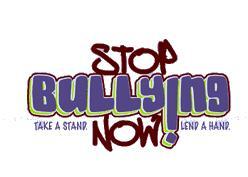Bullying Policy
All students have the right to a safe and healthy school environment.
MANCOS SCHOOLS' ANTI-BULLYING RULES
Rule 1: We Will Not Bully Others.
Rule 2: We Will Try to Help Students Who Are Bullied.
Rule 3: We Will Try to Include Students Who Are Left Out.
Rule 4: If We Know That Somebody Is Being Bullied, We Will Tell an Adult at School and an Adult at Home.
Bullying Prevention and Education (Policy JICDE)
The Board of Education supports a secure school climate, conducive to teaching and learning that is free from threat, harassment and any type of bullying behavior. The purpose of this policy is to promote consistency of approach and to help create a climate in which all types of bullying are regarded as unacceptable.
Bullying is the use of coercion to obtain control over another person or to be habitually cruel to another person. Bullying can occur through written, verbal or electronically transmitted expression or by means of a physical act or gesture. Bullying is prohibited on district property, at district or school-sanctioned activities and events, when students are being transported in any vehicle dispatched by the district or one of its schools, or off school property when such conduct has a nexus to school or any district curricular or non-curricular activity or event.
A student who engages in any act of bullying is subject to appropriate disciplinary action including but not limited to suspension, expulsion and/or referral to law enforcement authorities. The severity and pattern, if any, of the bullying behavior shall be taken into consideration when disciplinary decisions are made.
The superintendent shall develop a comprehensive program to address bullying at all school levels. The program shall be aimed toward accomplishing the following goals:
- To send a clear message to students, staff, parents and community members that bullying will not be tolerated.
- To train staff and students in taking pro-active steps to prevent bullying from occurring.
- To implement procedures for immediate intervention, investigation, and confrontation of students engaged in bullying behavior.
- To initiate efforts to change the behavior of students engaged in bullying behaviors through re-education on acceptable behavior, discussions, counseling, and appropriate negative consequences.
- To foster a productive partnership with parents and community members in order to help maintain a bully- free environment.
- To support victims of bullying by means of individual and peer counseling.
- To help develop peer support networks, social skills and confidence for all students.
- To recognize and praise positive, supportive behaviors of students toward one another on a regular basis.
Adopted: July 16, 2001
Reviewed: March 2006 by Policy Review Committee
Policy Manual Updated November 2006 to Reflect CASB Recommendation
By Policy Review Committee June 2010
Revised: August 16, 2010
LEGAL REF.: C.R.S. 22-32-109.1(2)(a)(X) (policy required as part of safe schools plan)
CROSS REFS.: JICDA, Code of Conduct
JICDD*, Violent and Aggressive Behavior
JICJ, Student Use of Electronic Communication Devices
JKTop of Form, Student Discipline
In 2007, the district adopted the Olweus Bully Prevention Program. The Olweus [pronounced Ol-VEY-us] Bullying Prevention Program is a comprehensive, school-wide program designed for use in elementary, middle, and high schools. Its goals are to reduce and prevent bullying problems among school children and to improve peer relations at school. The program has been found to reduce bullying among children, improve the social climate of classrooms, and reduce related antisocial behaviors, such as vandalism and truancy. The Olweus Program has been implemented in more than one dozen countries around the world. http://www.clemson.edu/olweus/
PARENTS & FAMILY
 What Family Members Can Do
What Family Members Can Do
Bullying can be difficult to deal with, and if a love one is involved, it can be especially tough. What can you do to help?
- Learn as much as you can about bullying among children and youth.
- Talk with children in your family about bullying and your expectations about their behavior. Children and youth should know that you expect that they:
- Do not bully others
- Are helpful and kind to children and youth who are bullied
- Report bullying that they experience or witness to you or other adults
- Be watchful for possible signs of bullying among children in your family.
- Talking openly with children and youth in your home is important, but often children are reluctant to talk with adults about bullying that they've experienced or taken part in. Be watchful for behaviors and other signs that your child might be involved in bullying.
- Take immediate action if you suspect bullying.
- Work with school personnel and other adults in your community to prevent and reduce bullying.
All adults in a community have a responsibility to help keep kids safe and stop bullying among children and youth.
http://www.stopbullyingnow.com/
On March 10, 2011, at the White House Conference on Bullying Prevention, the President and the First Lady called for a united effort to address bullying. Approximately 150 students, parents, teachers, advocates, and policymakers convened to discuss how they can work together to make our schools and communities safe for all students. “If there’s one goal of this conference, it’s to dispel the myth that bullying is just a harmless rite of passage, or an inevitable part of growing up. It’s not,” President Obama said. “Bullying can have destructive consequences for our young people. And, it’s not something that we have to accept. As parents and students, teachers and communities, we can take steps that will help prevent bullying and create a climate in our schools in which all of our children can feel safe.”
FOR MORE INFORMATION, PLEASE GO TO http://www.whitehouse.gov/blog/2011/03/10/president-obama-first-lady-white-house-conference-bullying-prevention
